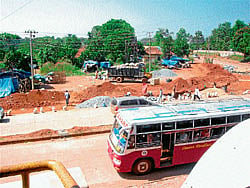Nowadays they spend $20,000 for a school bus to pick up the kids right up to the door so they don’t have to walk. They then spend $ 200,000 for a (home) gym so they can get some exercise. – Red Blanchard.

In India, particularly in cities, even in Tier-II cities like Mangalore, we do have school buses – but in many cases, no roads to run the buses on. So, even students, with their exclusive school buses, have to walk a bit before catching their transport.
They get enough exercise not to need, let alone afford, home gyms. But, when it comes to the average adult, public buses are the main avenues of transport and in many cases, they have to walk a lot to catch a bus either at the terminal or even at intermediate stages.
A properly designed bus terminal becomes critical in such situations. Take for instance, Bondel bus terminus on the City-Airport Road, now named after M Vishvesharaya. Its commuter watershed extends beyond Krisnanagar up to Gurpur River, close to three kms from the terminus.
Commuters have to trudge this distance, including the Remand Home uphill ascent, to reach Bondel junction where, presently, buses are parked on the road which has no apron. Even drivers and conductor, on arriving at the destination, make a beeline for the nearby bushes to ease their bladders,or worse, before their next trip which generally takes an hour.
This is where the properly planned bus terminus is critical. A bus station or terminal is a structure where city or inter-city or mofussil buses stop to pick up and drop off passengers. It is larger than a bus stop, which is usually simply a place on the roadside, where buses can stop.
It may be intended as a terminal station for a number of routes, or as a transfer station where the routes continue.
The largest bus station in the world is said to be Millennium Park Bus Depot in Delhi. Beyond the Delhi Millennium Park, large, modern bus terminals have come into operation or are being set up. For instance, Chennai’s Mofussil Bus Terminus, catering to outstation buses, is spread over an area of 37 acres – and is claimed to be the largest in Asia. On Apri 2, 2011, Chief Minister Naveen Patnaik laid the foundation stone for setting up of a state-of-the–art bus terminal in Bhubaneshwar to be completed in 30 months at a cost of Rs 105 crores.
The project is being implemented under Public-Private-Partnership (PPP) model on 14.43 acres of land. After 15 years, the terminus would be handed over to Orissa State Transport Corporation.
The PPP company will continue its commercial operations on six-acre land within the bus terminus. In Karnataka, we have the Majestic Circle bus terminus with all its chaotic functioning. According to a recent statement by the Transport Minister, for the first time in Karnataka, a Rs 250-crore project will be taken up under PPP model to construct a bus terminal at Hebbal.
Coming closer home to Mangalore, we have a poor record of serving commuters. For many years, the central terminus, catering both for city and service (mofussil and inter-city) was located at Hampankatta, behind Ballal Mahal, with a back-up building at the centre. Since many years the terminal has been shifted to Central Maidan (service buses), with covered aprons and bays and city buses to an open road off State Bank.
This arrangement reflects poorly on the city’s pride. Mercifully, now plans are afoot to shift the central terminal to a plot under development off Mahavir Circle, east of the National Highway. If the record of time-frame of completing government projects is anything to go by, one may have to wait for long for the terminus to fructify.
While we concentrate on the central terminus, there is no focus on outreach terminals even in the realm of ideas. The MUDA Deveopment Plan should have consciously reserved for “Public Purpose” plots for terminals like Bondel, Kunjetbail, Neermarga, Padil and Suratkal.
While in many of these points, land is still available, if government does not notify and acquire land for terminals, the available land is in danger of encroachment, creating hurdles. As for terminals within the city, like Mangaladevi and Morgan Gate, where exclusive open space is scarce, one can have canopies across the roads – as in the case of toll stations on highways.
Such canopies will protect the waiting commuters from the harsh sun and heavy rains. Properly designed terminals can have information boards, and announcement arrangements, like they have in railway stations and airports. There would be toilets and waiting lobbies for commuters and rest rooms for drivers and conductors. These can be built on PPP model and can be self-financing and profitable for commercial exploitation.
Finally, E B White describes a commuter as “one who spends his life in running to and from his wife”. With Women’s Lib, the once dubbed weaker sex could also be running to and from their husbands. Let them all commute in comfort – with little help from modern bus terminals.
